Beyond the Beat At The Canadian Museum for Human Rights
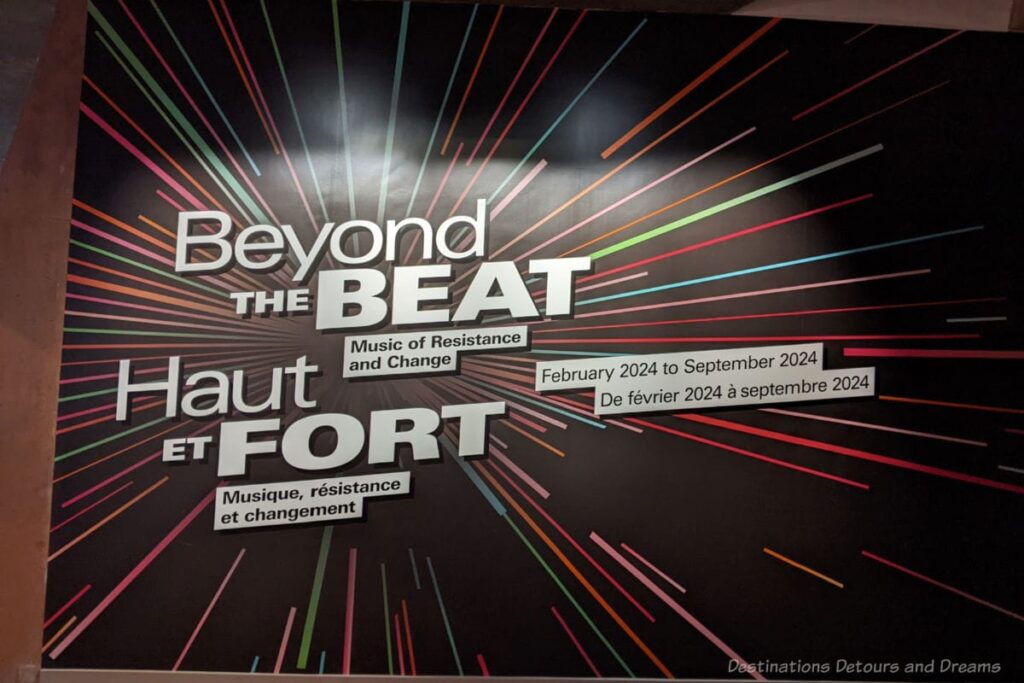
Beyond the Beat: Music of Resistance and Change exhibit at Canadian Museum for Human Rights in Winnipeg, Manitoba, Canada
The exhibit Beyond the Beat: Music of Resistance and Change at the Canadian Museum for Human Rights (CMHR) in Winnipeg, Manitoba, Canada explores ground-breaking and history-making moments where popular music played a pivotal role in social and political transformation. The Canadian Museum for Human Rights, which highlights human rights struggles and successes around the world, opened in 2014. Beyond the Beat was created as something special for the museum’s tenth anniversary year and it is a fabulous exhibit.
In the description of the exhibit on CMHR’s website, music is said to be a powerful force for social and political change. A panel at the exhibit’s entrance describes music as the soundtrack of life and says it is there at every moment, in war and peace, in the struggle for human rights, in tragedy and triumph. It is the voice of “us.”
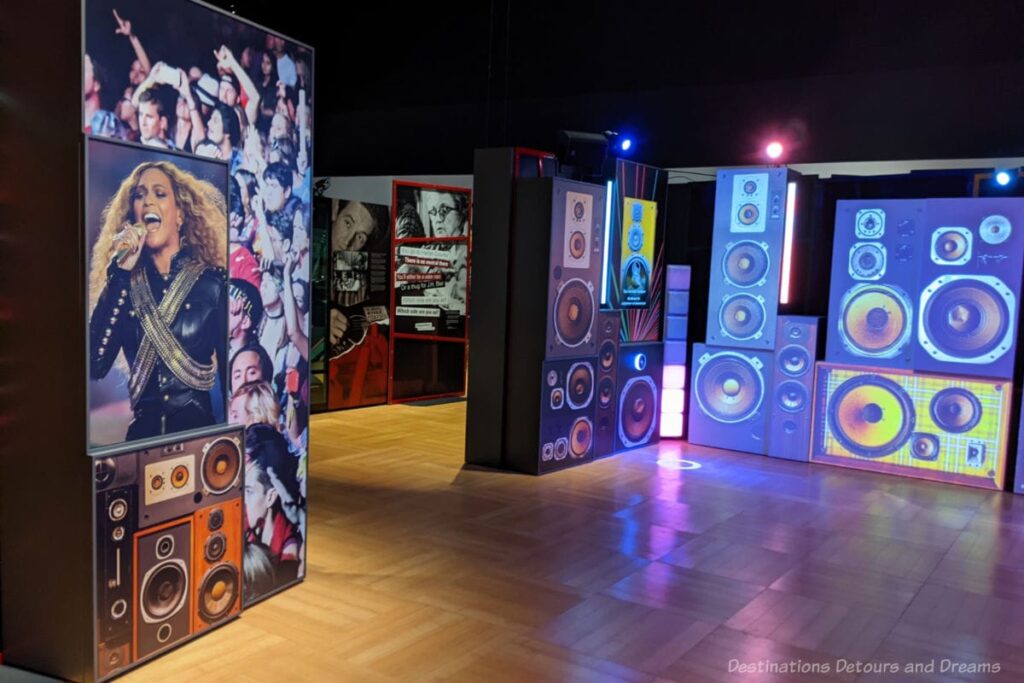
Large colourful panels, organized into themes, fill the gallery. Those panels contain textual information and photos, artfully arranged to engage the viewer. Display cases hold artifacts such as album covers, posters, instruments owned by musicians, and stage outfits. And, of course, there is music. You are given an RFID disc that looks like a record at entry. You use it at numerous spots throughout the exhibit to activate music, performance footage, and interview clips.
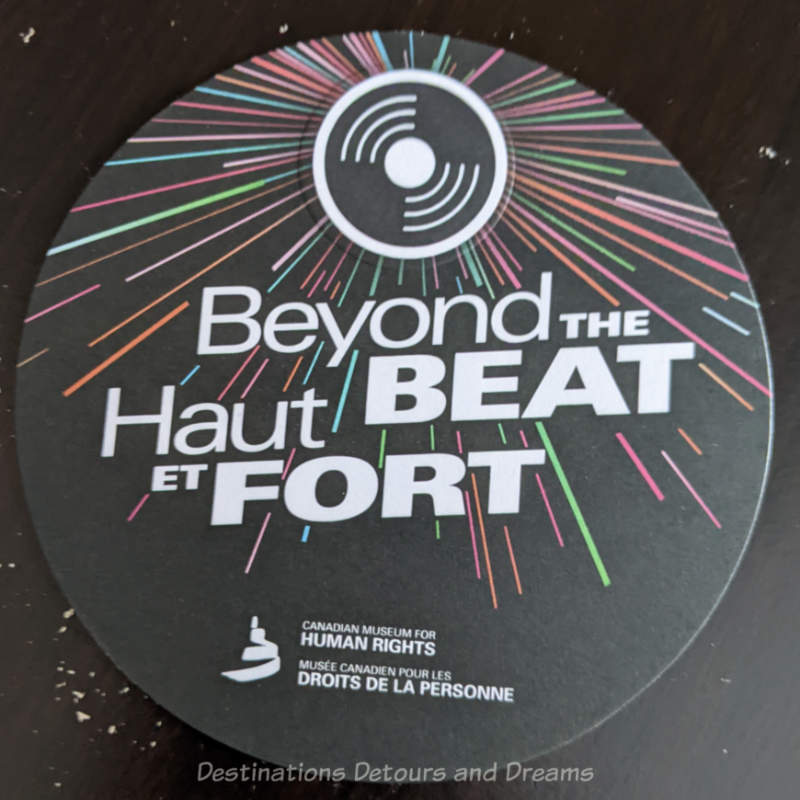
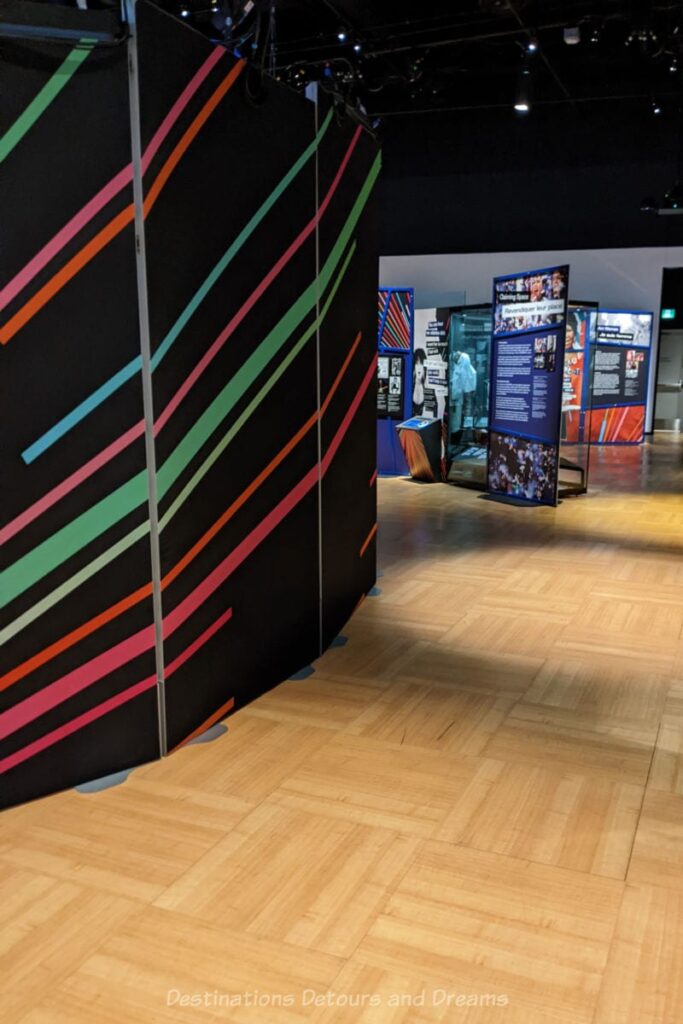
One set of panels focuses on banned music, such as Neil Young’s Ohio recorded by Crosby, Stills, Nash, and Young about the 1970 shooting of student protestors at Ohio’s Kent State University and Loretta Lynn’s The Pill. There’s a clip about Elvis, whose music was considered too provocative for youth. When he first toured Canada in 1957, one Ottawa school expelled students for attending the concert. The Beatles, Jimi Hendrix, and Madonna are also highlighted in this section, as well as Indigenous musician Link Wray’s 1958 song Rumble, the only instrumental song to have been banned by U.S. radio stations because it was thought the title promoted youth violence.
Other panels highlight music tackling poverty, class struggle, and injustices faced by working-class people, from the labour songs of Woody Guthrie and Paul Robeson to the rise of punk rock in the mid-1970s and the birth of hip hop in the late 1970s when the economic recession hit black communities especially hard. One panel states that “hard times inspire new voices” and highlights the music of Ani DiFranco and Billy Bragg.
There’s information about pushing for climate change and finding greener practices in music production.
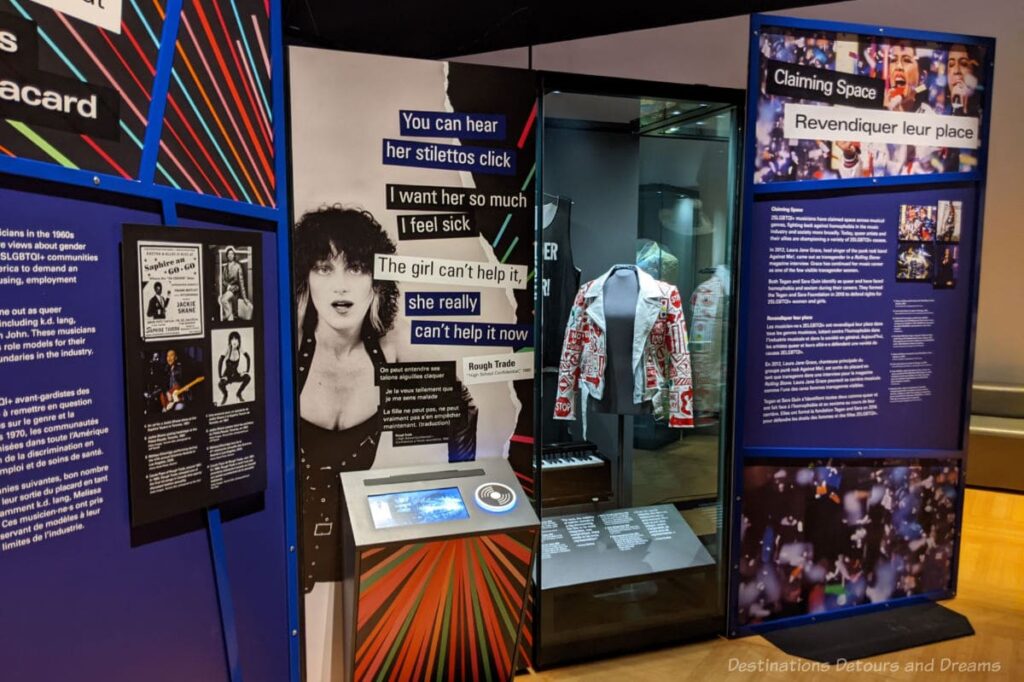
Music played a significant role in the growth of feminist and 2SLGBTQI+ movements. You’ll find displays about women channeling anger at gender inequality through music and the breaking of barriers for women in music. There are photos of the 1969 police raid on New York’s City’s Stonewall Inn, a queer bar and dance hangout, and information about musicians using their platform to challenge boundaries regarding gender expression, sex, and sexuality.
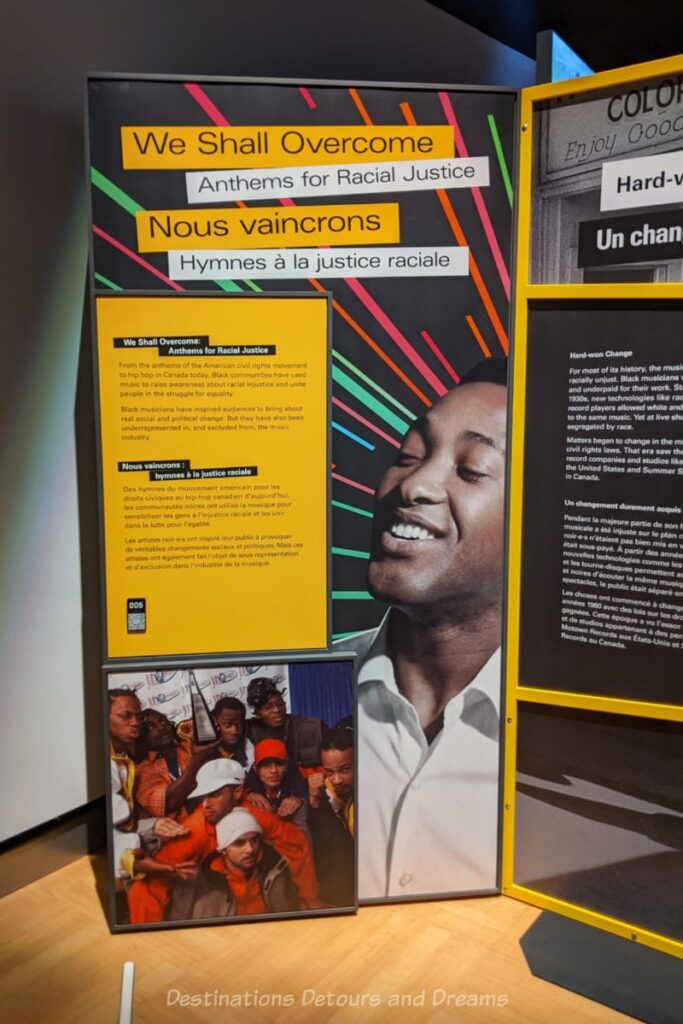
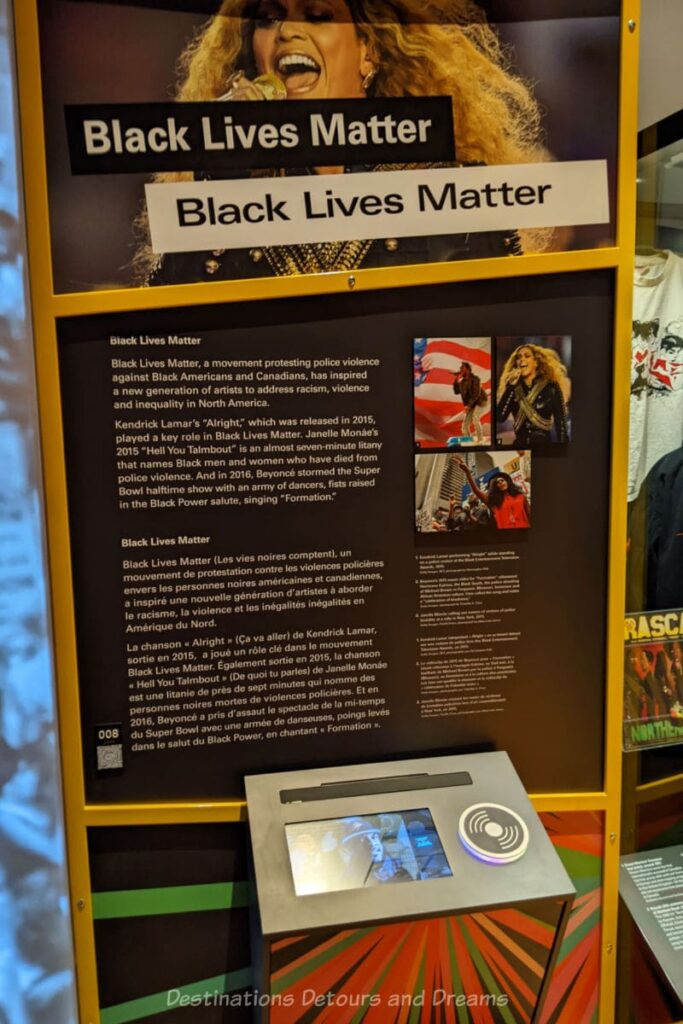
A section of the exhibit shows how Black communities used music to raise awareness of racial injustice and unite people in the struggle for equality.
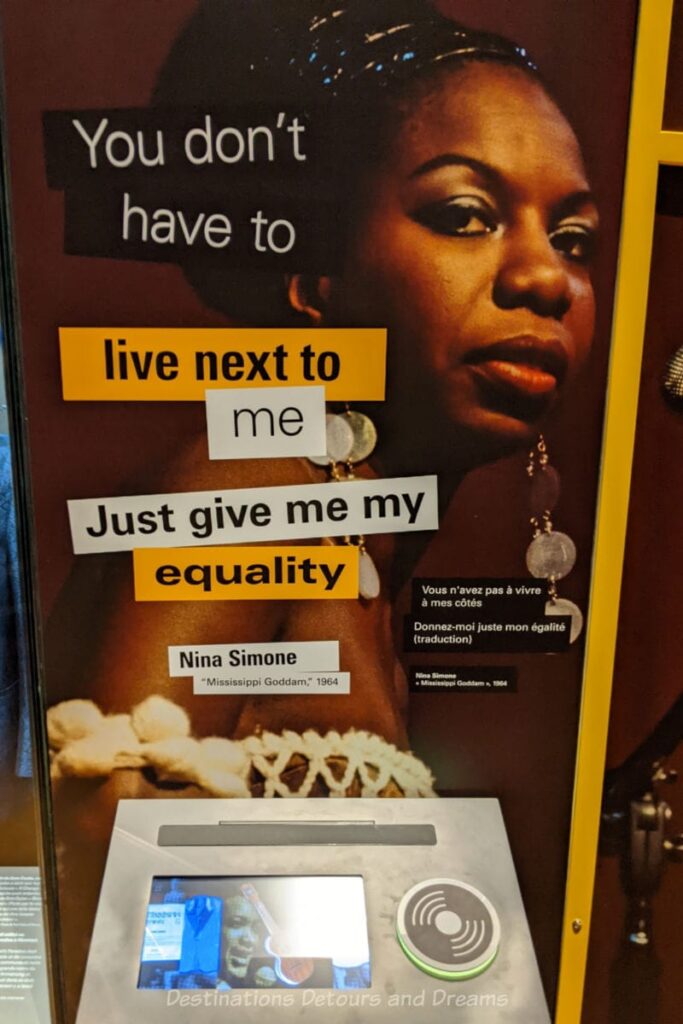
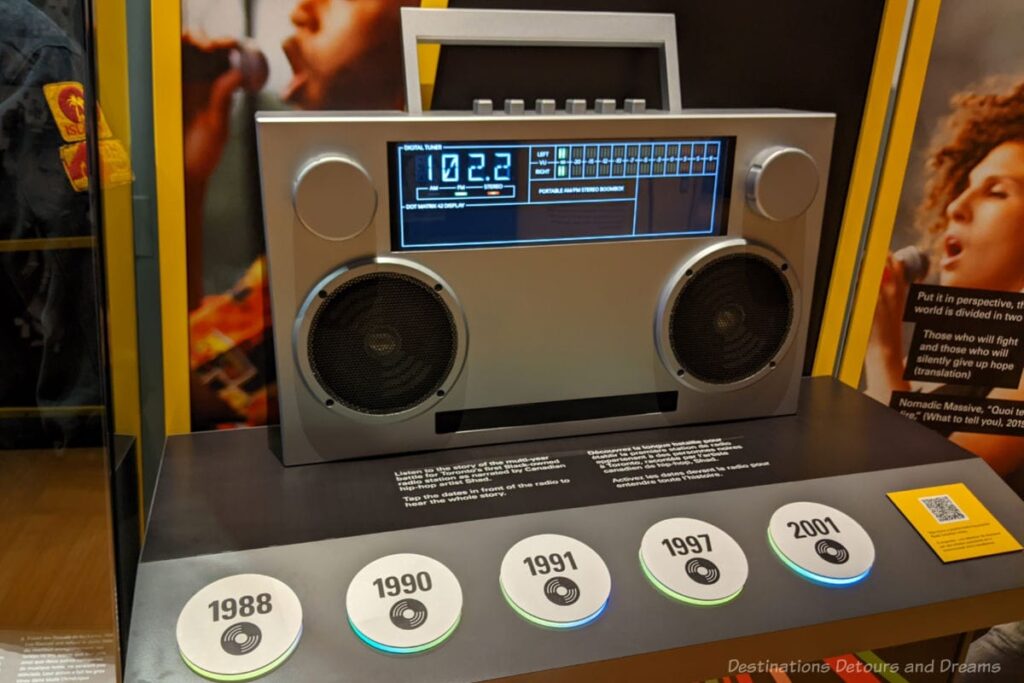
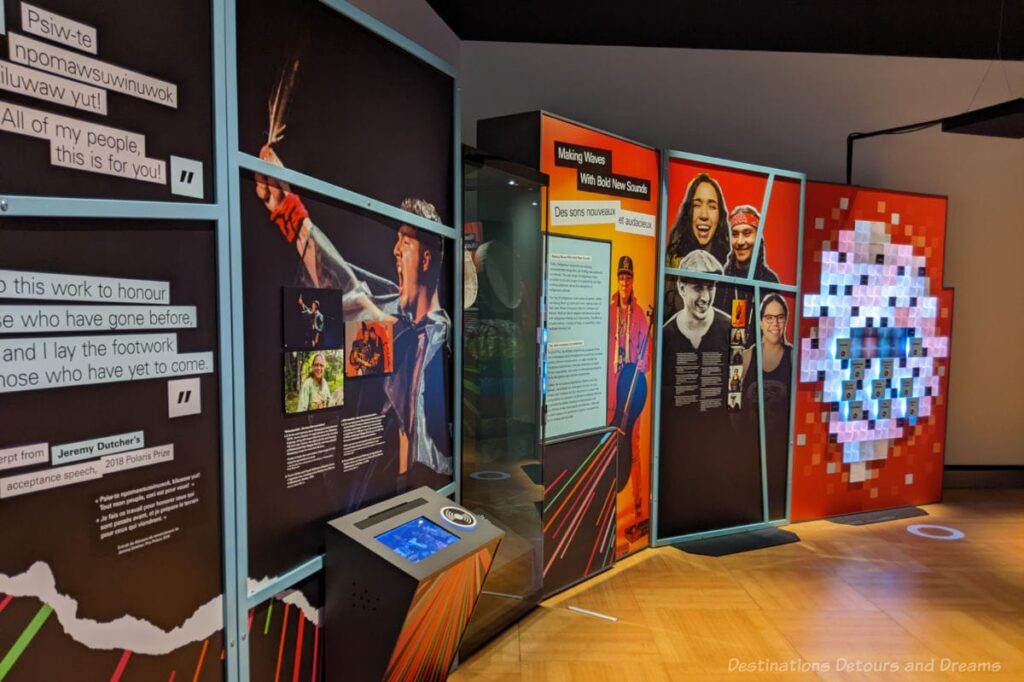
A section on Indigenous music showcases the vast range of Indigenous music across all genres as a telling statement of the resurgence of Indigenous cultures. You have the opportunity to hear a good selection of those artists. Panels speak to the musicians challenging colonialism and giving voice to the pursuit of rights. “They hear not only the power of the music, but its truth.”
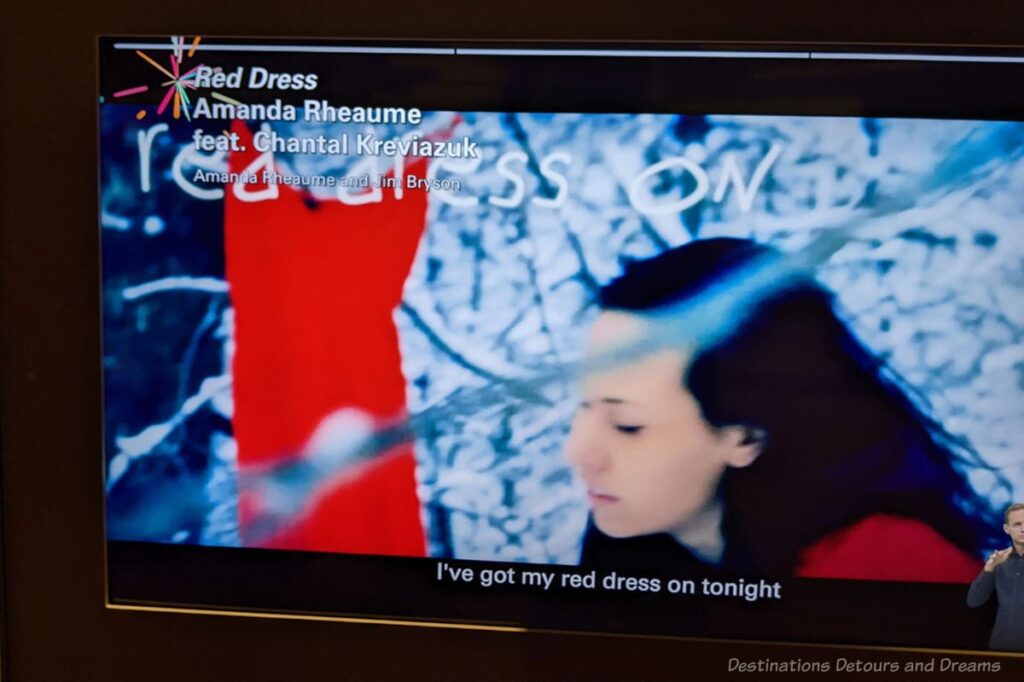
Once of the many music videos I enjoyed watching and listening to features Red Dress by Amanda Rheaume featuring Chantal Kreviazuk, a song meant to honour and raise awareness about Murdered and Missing Indigenous Women and Girls (MMIWG). Red dresses have become a symbol of the MMIWG after Jaime Black’s REDress art project. (Note: You can find an installation of that art project in the CMHR’S Canadian Journeys gallery.)
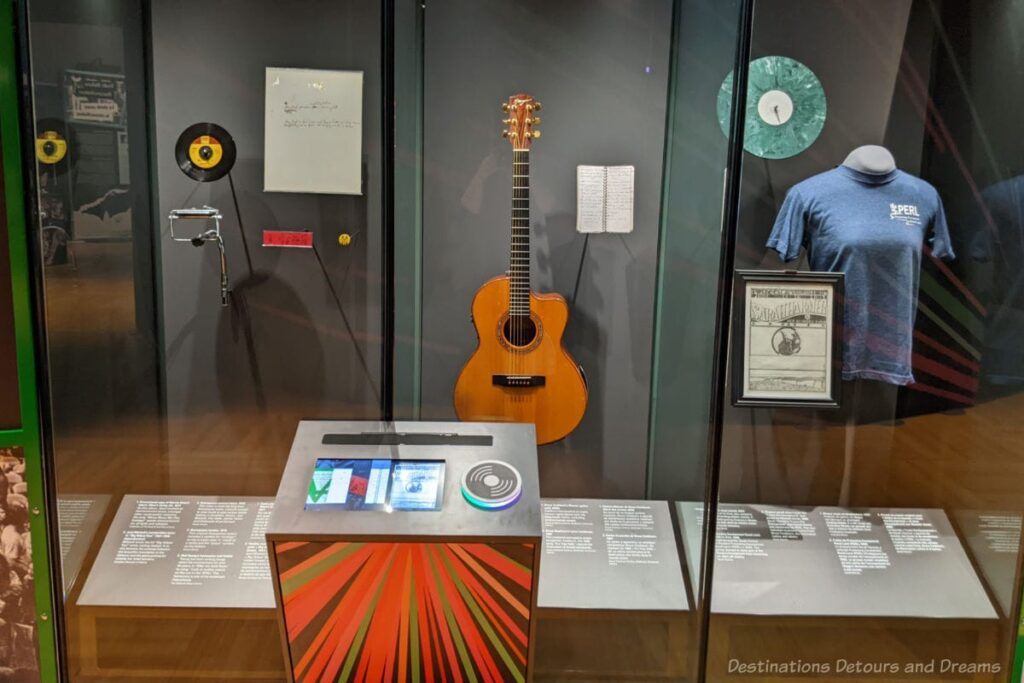
Artifacts peppered throughout the exhibit include Bruce Cockburn’s Manzer guitar, Joni Mitchell’s handwritten lyrics to Big Yellow Taxi, Neil Young’s harmonica, a flamboyant Elton John jacket, Oscar Peterson’s tuxedo jacket, a Greenpeace concert ticket, Ani DiFranco’s overalls, and Inuit singer Susan Agulark’s tuiluk (jacket) and 2005 Juno award. There’s Sarah McLachlan’s Lilith Fair outfit. McLachlan and friends founded Lilith Fair in the 1990s as a way to feature more women artists. There’s a souvenir program for Paul Robeson’s fourth Peace Arch concert in 1955. Robeson was not allowed to leave the U.S. due to his activism, but he sang to tens of thousands of Canadians who sat just across the international border. This is only a small sampling of items on display.
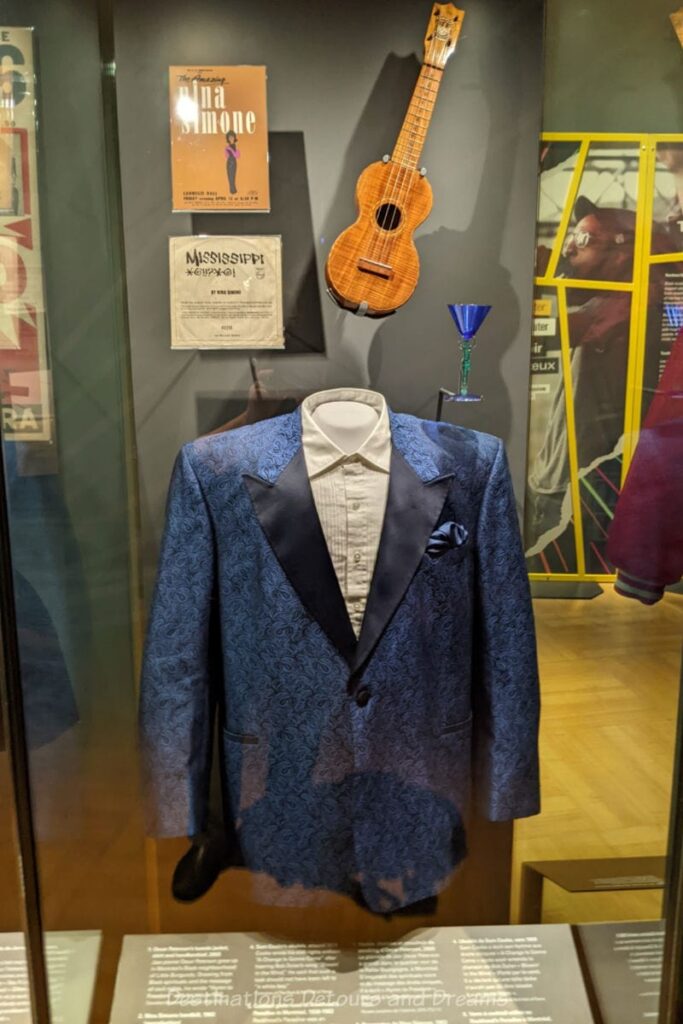
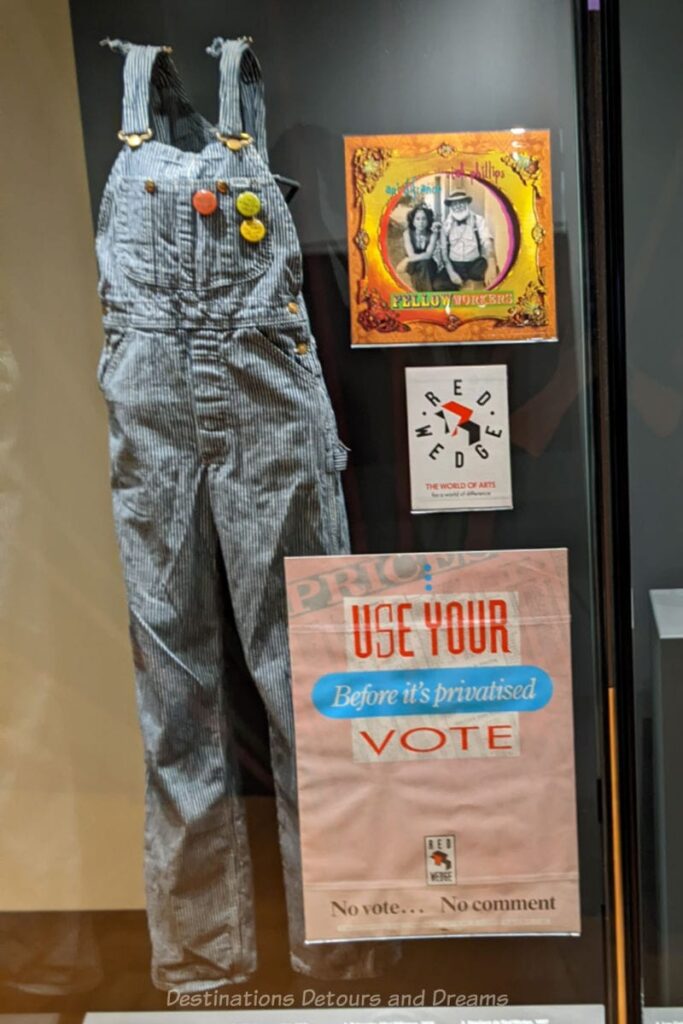
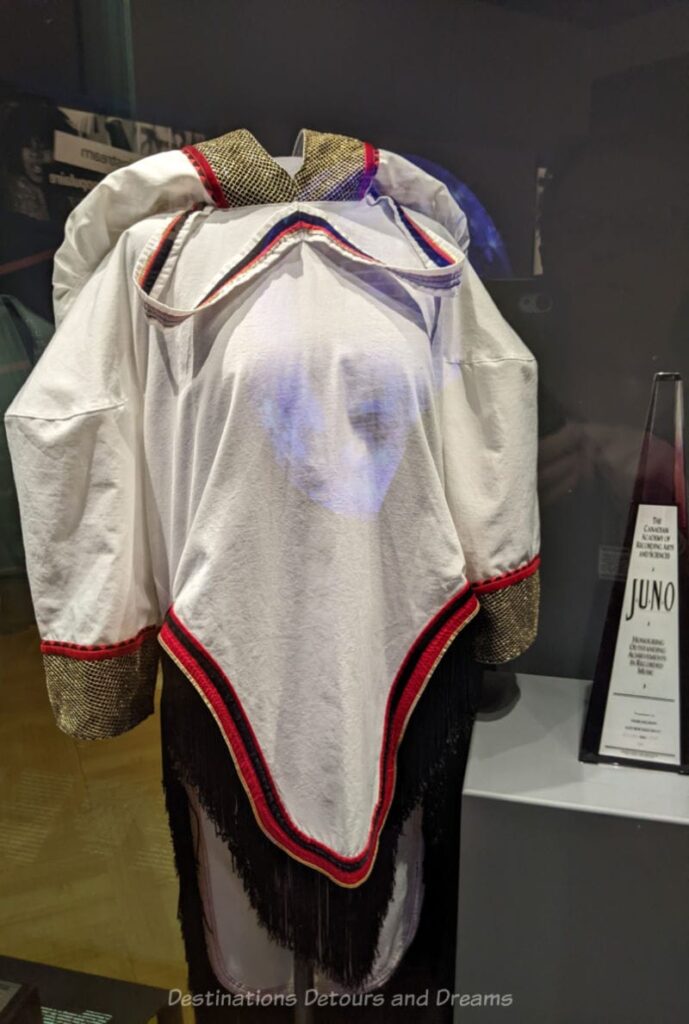
And then there is the music. You’ll want to sing along and maybe march to We Shall Overcome and dance to the Village People’s YMCA. Some of the songs may bring back memories. Others may be new to you. They all remind us of the power of music to move us.
The exhibition takes place in CMHR’s main floor gallery and runs from February 2024 to September 2024. Entry is included with the price of CMHR admission. A small portion of the exhibit, a display about the American band Rage Against the Machine, can be found on the sixth floor. For more information on the CMHR and its other galleries, read my post Guide to the Canadian Museum for Human Rights.
There is a lot to take in in this exhibit. It seems to invite repeat visits. I know I plan to attend again.
Never miss a story. Sign up for Destinations Detours and Dreams free monthly e-newsletter and receive behind-the-scenes information and sneak peeks ahead.
PIN IT

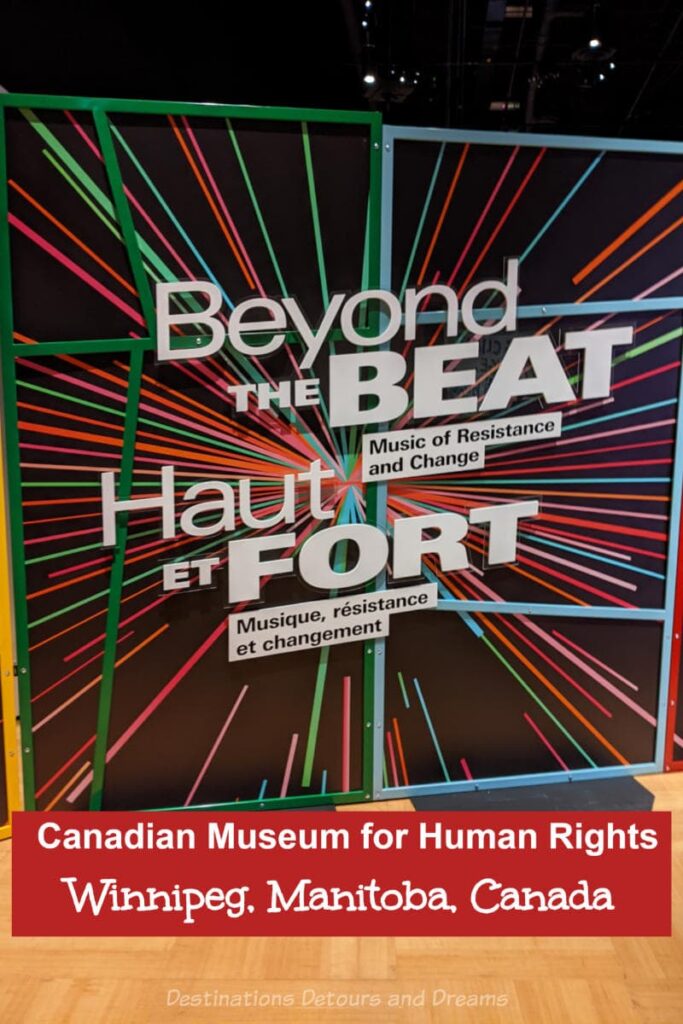

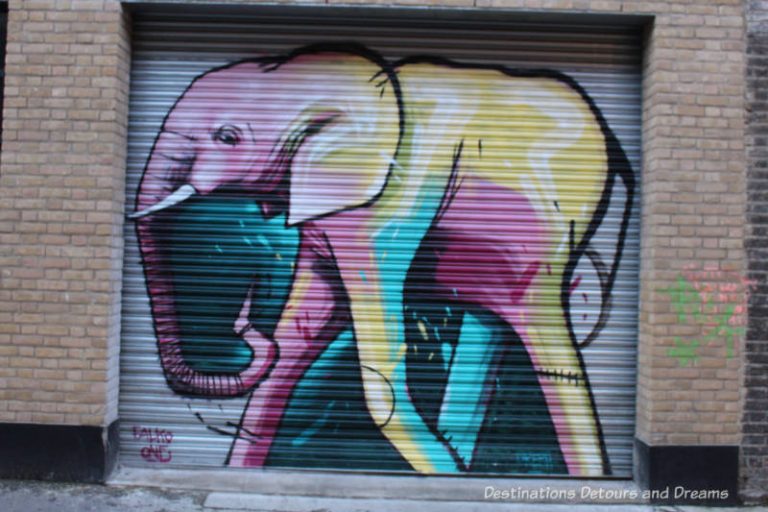




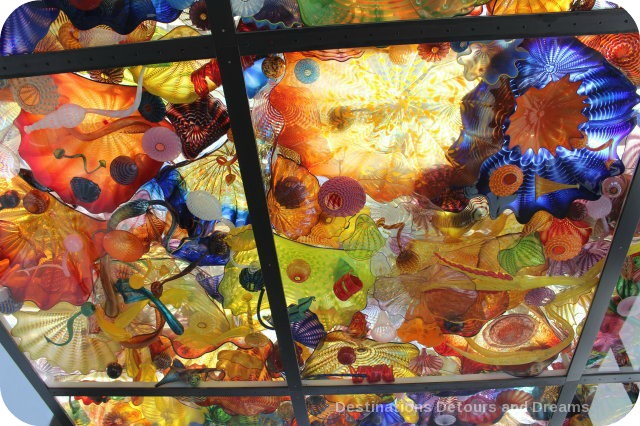
We had friends up from Wisconsin and we took them to the Museum. Not the we shouldn’t forget the pain and suffering certain individuals suffered at the hands of the Nazi’s in WW11 we all felt it was the the basic theme and was poorly presented and quite honestly boring.
As for the building itself, someone should take Antoine Predock’s crayons away. That has to be the ugliest
building in Winnipeg! This was also the impression that was shared by our American friends!
Thanks for commenting Hartley. It’s always interesting to hear others’ reactions. I like the design of the museum, but can understand how the unusual architecture may not appeal to everyone. I am surprised, however, that you felt the Holocaust was the prime theme. It is only one of seven galleries (although it is the darkest both literally and figuratively in my opinion). There is a lot of content in the other galleries. I find the Canadian Journeys one particularly interesting. Given your reaction, I imagine seeing Beyond the Beat is not high on your list, but if you were to take it in I’d be interested in what you thought of it.
That looks like a great exhibit. I was especially interested in reading about the banned music. Crazy enough that Ohio was banned, but banning an instrumental!
Hi Ken, that was an interesting part of the exhibit. It was also cool to hear bits of the songs that caused the controversies.
Your travel blog beautifully delves beyond the surface, offering a profound exploration of the Canadian Museum for Human Rights. The accompanying pictures capture the essence of each exhibit, invoking empathy and understanding in every viewer.